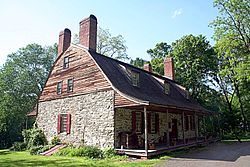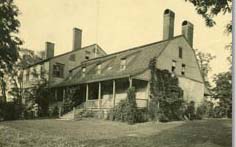Mount Gulian Historic Site, overlooking the Hudson River in New York State, was originally built by New York City merchant Gulian Verplanck between 1730 and 1740 as a summer residence. The Verplanck family lived at the estate until 1931 at which time it was destroyed by fire and the family was forced to abandon it. It lay in ruin until 1966 when the Mount Gulian Society, with an initial membership comprised of family members and members of the Society of the Cincinnati, was formed with the intention of reconstructing the homestead. The site today consists of the reconstructed eighteenth-century house, an eighteenth-century Dutch barn, a restored nineteenth-century garden, and 44 acres overlooking the Hudson. Mount Gulian became the headquarters of the New York State Society of the Cincinnati in 1995.
Since opening to the public as an historic house museum in 1975, Mount Gulian has welcomed tens of thousands of visitors and has offered numerous educational programs and events with a special concentration on the American Revolution. Mount Gulian is historically significant because it served as the headquarters of General von Steuben in 1782-83 and is the birthplace of the Society of the Cincinnati, May 13, 1783.
An interpretive exhibit about the Society of the Cincinnati can be seen at Mount Gulian. Four large panels measuring 60"x48" tell the story of the Cincinnati's founding and later history up through the present. Items from the museum's collection on display include: an epaulet worn by Colonel Henry Emanuel Lutterloh, a Revolutionary War officer; an early membership certificate from 1785; an 1857 wooden ballot box donated by the New York State Society of the Cincinnati; and a replica of the Institution donated by the Society of the Cincinnati in the State of Connecticut.
With a history spanning 300 years, Mount Gulian has ties to the times of the early Dutch settlers and the Native American Indians; Verplanck family members - politicians, authors, gardeners and a captain of African American troops in the Civil War; and James F. Brown, an escaped slave who worked for the Verplancks and whose freedom was purchased by the family.
Through public programs and events, visitors learn of our nation's rich and diverse history. By providing engaging, innovative programming that appeals to visitors of all ages Mount Gulian shows the fascination of events, personalities, and outcomes while emphasizing the drama and personal interest of it all. The school programs, in particular, invigorate teachers' classroom lessons, allow educators to move their students beyond textbooks, and enable them to expand their classroom to the community.
Mount Gulian's mission is to educate visitors about the individuals, events and ideals that formed our country, so as to advance the understanding of what it means to be an American and to value the democratic principles that define and sustain our nation.



